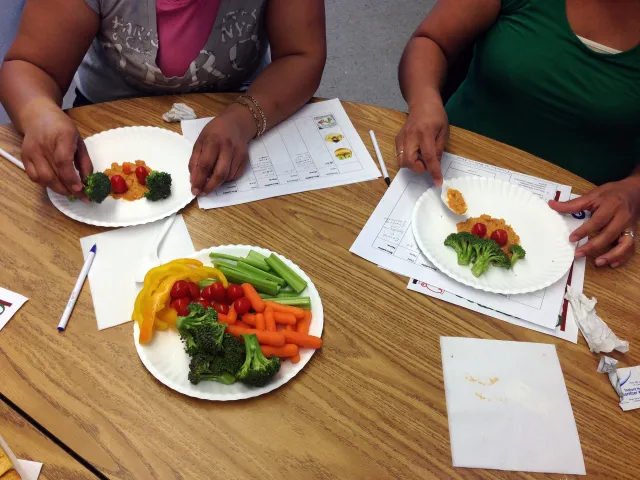Background: Snacking has increased among US children over the past 30 years. Children ages 2-6 years consume more than a quarter of their daily calories from snacks, mostly from high-fat, salty snacks; sweets; and sugary drinks.
Parents and caregivers should set a schedule for snacks and decide what to offer. Offering healthy snacks is one way to make a shift to a healthier eating pattern. Examples of healthy snacks include:
- Plain air-popped popcorn (a whole grain), rather than cookies
- Plain low-fat yogurt with fresh fruit rather than ice cream
- Veggies with garbanzo dip, instead of chips and sour cream
- Low-fat milk or plain water, rather than a soda
The MyPlate website provides useful tips on snacking for parents.

Teaching Tip: Involve children in the fun snack activity, if possible. If some participants struggle in the “plan your child's meals and snacks” activity, share examples from other groups or limit the activity to scheduling and planning only one snack.
Key Message: Plan and serve healthy snacks to young children.
Target Audience: Mexican-origin families with young children, ages 3 to 8 years
Objectives: By the end of the lesson, participants will be able to:
1) Identify what foods make a healthy snack;
2) Explain why children need a regular structure of meals and snacks; and
3) Plan a day of healthy snacks.
Materials:
- Powerpoint slides, projector, laptop;
- Pencils and worksheet;
- For activity and food tasting: hummus (see Veggie Dip), whole wheat breads, carrots sticks, cherry tomatoes (in halves), broccoli, cucumber, grated cheese, paper plates (1 per participant) and small plastic bowls for supplies.
Handouts: Recipes (see Veggie Dip below), snack schedule worksheets
Set-up: Set up projector and laptop for slides. If it is not possible to use a slide projector, write out Edgar’s day on poster paper and display ahead of class. Print a few color pictures from the slide to show to participants. Place washed vegetables pieces and cheese into small plastic bowls, arranging one set of bowls for each table or small group.
Click here to download complete English version lesson plan.
Lesson 1.7 Offer healthy snacks(English)
Handouts and Activity Sheets
Veggie Dip (English) (Spanish)
Plan Your Child's Meals and Snacks Activity Sheet (English) (Spanish)
Visual Aid Slides with Edgar's Day (Bilingual)
Other Resources
MyPlate snack tips for parents (English)
